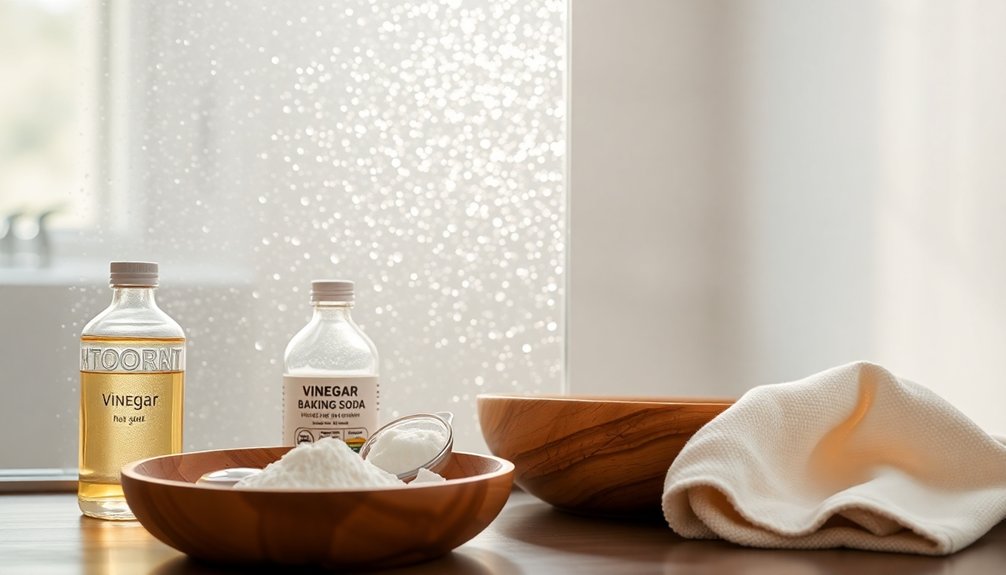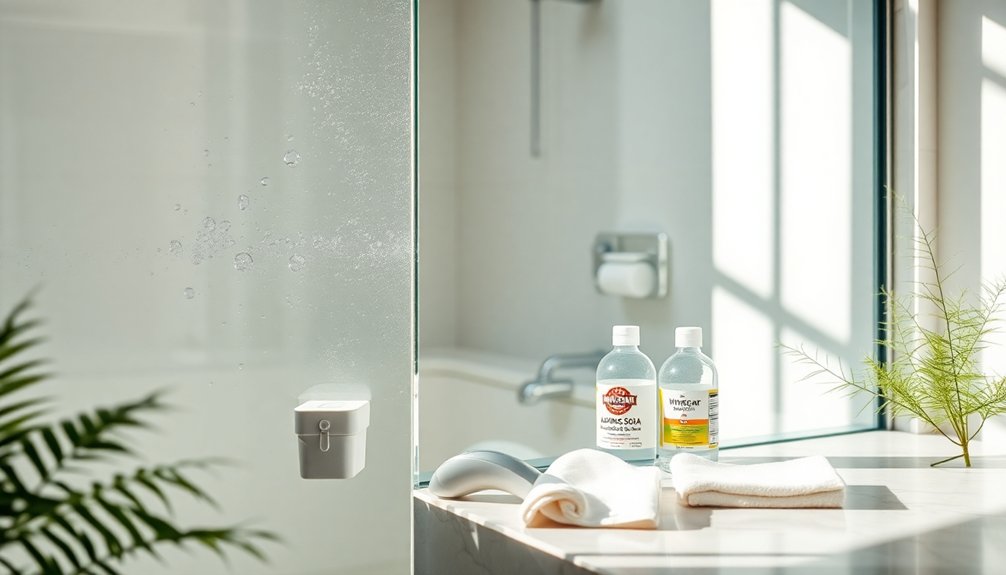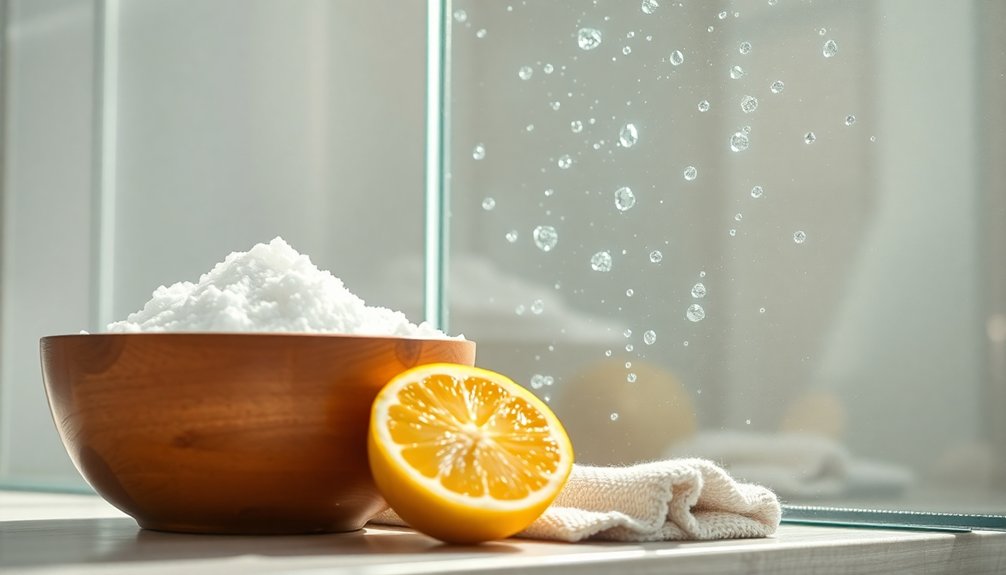To clean years of soap scum without harsh chemicals, use a mixture of equal parts distilled white vinegar and dish soap. Apply it directly to the affected areas and let it sit for 15-20 minutes. You can also create a paste of baking soda and vinegar to tackle stubborn spots. Regular maintenance, like wiping surfaces after use and scheduling weekly cleanings, can help prevent future buildup. Discover more effective techniques to keep your surfaces sparkling clean.
Understanding Soap Scum
Soap scum can be a frustrating nuisance in your bathroom. It’s a sticky film formed by a combination of soap residue, hard water minerals, body oils, and dirt.
When you use soap with hard water, the minerals react, leading to soap scum build-up on shower walls, tubs, and fixtures. Over time, this accumulation can become thick and difficult to remove. The interaction between soap and hard water minerals is a key factor in soap scum formation.
To prevent soap scum, consider switching to liquid soap, which reduces residue. Regular maintenance is also key: wipe down surfaces after each use and clean at least once a week.
Preparing for the Cleaning Process
Before diving into the cleaning process, it’s important to gather everything you need to guarantee efficiency and safety.
Start by putting on rubber gloves to protect your hands and safety goggles to shield your eyes from splashes.
Next, obtain a scrub brush or sponge with abrasive bristles. This will help you tackle stubborn soap scum effectively.
Collect natural cleaning agents like distilled white vinegar, which is a powerful and safe alternative to harsh chemicals.
Ascertain proper ventilation by opening windows or using fans to disperse any fumes from your cleaning solutions.
Finally, clear your cleaning area by removing any items or obstacles that might hinder your access to the surfaces affected by soap scum. Regular use of DIY non-toxic cleaners ensures a hygienic space without safety compromises.
Effective Cleaning Techniques

When tackling soap scum, natural cleaning solutions can be your best friends. You can easily create effective DIY mixtures using common household items like vinegar, baking soda, and dish soap. These techniques not only save you money but also minimize the use of harsh chemicals in your home. Regular use of these remedies can prevent soap scum buildup and maintain a fresh shower experience.
Natural Cleaning Solutions
Cleaning soap scum can be a breeze with natural solutions that are both effective and safe. You can create a powerful cleaner by mixing equal parts distilled white vinegar and dish soap. Let it sit for 15 minutes before scrubbing.
For tougher stains, try a baking soda paste combined with vinegar. This fizzing reaction loosens soap scum, so let it sit for 20 minutes before scrubbing.
Hydrogen peroxide is another great option; apply it directly to the soap scum and let it penetrate for 15-20 minutes.
Additionally, rub lemon halves on the scum or mix lemon juice with water in a spray bottle for a fresh-scented cleaner.
These natural cleaning solutions help you tackle soap scum without harsh chemicals.
DIY Techniques Overview
To effectively tackle soap scum, you can utilize a variety of DIY techniques that harness common household ingredients.
One powerful method is combining equal parts vinegar and baking soda; let it fizz and sit for 15-20 minutes before scrubbing to remove soap scum.
Another effective cleaning solution is mixing Blue Dawn dishwashing liquid with white vinegar in a spray bottle, allowing it to sit for 30 minutes to overnight.
You can also use hydrogen peroxide mixed with baking soda for a disinfecting fizz.
For stubborn stains, apply a Borax and water paste, letting it sit for 20 minutes.
Finally, rub lemon juice directly onto soap scum or mix it with water, waiting 10-15 minutes before rinsing for a fresh scent.
Cleaning Solutions
Several effective cleaning solutions can help you tackle soap scum without resorting to harsh chemicals.
One powerful DIY cleaning solution combines one cup of Blue Dawn dishwashing liquid with three cups of white vinegar in a spray bottle. This mixture can easily remove stubborn soap scum.
You can also create a paste with baking soda and vinegar; apply it to the affected areas and let it sit for 15-20 minutes before scrubbing.
Another option is using hydrogen peroxide mixed with baking soda, where the fizzing action indicates effectiveness against soap scum and mold.
Finally, lemon juice can dissolve soap scum and leave a fresh scent when applied directly or diluted in water.
Incorporating natural cleaning agents into your routine ensures a safer home environment while effectively maintaining your bath fixtures.
Choose non-toxic alternatives for a safer home environment.
Preventive Measures and Maintenance

To keep soap scum at bay, consider switching to liquid or gel soaps that leave less residue. Make it a habit to wipe down surfaces after each use to prevent buildup and simplify cleaning. Installing a water softener can also help reduce hard water minerals that contribute to soap scum formation. Additionally, using effective cleaning tools like microfiber cloths and natural solutions can enhance your cleaning routine and prevent future buildup.
Switch to Liquid Soaps
Switching to liquid soaps can make a noticeable difference in your bathroom maintenance, as they leave behind less residue than traditional bar soaps.
Liquid soaps dissolve more easily in water, preventing soap scum buildup caused by the reaction between bar soap and hard water minerals. By choosing liquid soaps, you’ll maintain cleaner surfaces with less effort, minimizing the need for frequent deep cleaning.
Many liquid soaps contain surfactants that efficiently break down oils and dirt, allowing for a cleaner rinse and further reducing soap scum accumulation.
Additionally, opting for liquid soaps can be an environmentally friendly choice, as many brands offer biodegradable and eco-conscious formulations.
This simple switch can transform your cleaning routine and enhance your bathroom’s overall cleanliness.
Regular Surface Wiping
Regularly wiping down your bathroom surfaces after each use can make a big difference in preventing soap scum buildup.
Use a microfiber cloth or sponge to easily remove excess water and prevent moisture from accumulating. This simple practice not only helps keep surfaces clean but also reduces the effort needed for deep cleaning later.
Incorporate a weekly cleaning routine with mild soap and water to maintain a fresh environment and eliminate any lingering residue.
Switching to liquid or gel soaps can further minimize soap remnants on surfaces.
Install Water Softener
If you want to effectively combat soap scum in your bathroom, consider installing a water softener. This device can greatly reduce the hardness of water by replacing hard minerals like calcium and magnesium with sodium ions.
As a result, you’ll minimize soap scum formation on your surfaces, making cleaning easier. Softened water enhances the effectiveness of soaps and detergents, allowing them to lather better and leaving less residue behind.
To maintain your water softener, remember to periodically replenish its salt supply to guarantee it functions efficiently.
Investing in a water softener not only cuts down your cleaning efforts but also extends the lifespan of your plumbing fixtures and appliances, ultimately saving you time and money.
Helpful Tips on How to Avoid Soap Scum

To keep soap scum at bay, consider opting for liquid or gel soaps instead of traditional bar soaps, as they leave behind less residue.
Installing a water softener can also help, as it reduces hard water minerals that contribute to soap scum formation.
Incorporate a simple cleaning routine by wiping down bathroom surfaces after each use. This quick task eliminates moisture and soap residue, preventing buildup.
Additionally, use a squeegee after each shower to remove excess water from glass and tiles, keeping surfaces dry.
Finally, clean your shower or bathtub at least once a week with a mild soap to maintain a clean environment and further reduce soap scum accumulation. Using vinegar soak can be an effective method to tackle any existing soap scum.
Stay proactive for a soap scum-free bathroom!
Conclusion
By following these steps, you can transform your bathroom from a soap scum jungle into a sparkling oasis. Regular maintenance and the right techniques will keep the buildup at bay, ensuring your surfaces shine like new. Remember, a little prevention goes a long way in avoiding that pesky residue. So, arm yourself with these cleaning methods, and watch your space glow with cleanliness, making it a welcoming retreat every time you step in.